Lets visit the show from a visitors stand point. Arriving
at Oshkosh in your camper van you are directed by the signs to the airshow - campers use
left lane. You drive up to the window where EAA volunteers check EAA members in. Camping
costs just over $100 for the week. For this you get access to showers, a general store,
garbage pickup, washrooms, and water- a lot like a small municipality. One little problem
is that this gives you access to the campground - which in some cases is a mile from the
main show area. For access to the actual flight line requires you to pay an addition fee
PER DAY for a flight line pass.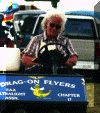
Since we are "ultralighters" we will be staying in the "ultralight
campground" or the "John Moody campground" named after what many consider
to be the "Father of Ultralights."
On entering the campground we are greeted by Nancy - our "Denmother". The thing
about Nancy is that it doesn't matter how big of a chip you have on your shoulders
regarding EAA's "money gouging" - as soon as you see her smile and listen
to that voice it just doesn't matter anymore - you are NOW with friends.
Nancy puts a
little sticker on the truck to designate you as a "true ultralighter" this is
necessary because of the limited space allotted to the ultralight camping area. Nancy then
allows you to find a spot, warning not to block the area of garbage pick up or toilet
cleaning. But her job doesn't end there, to make sure that the site isn't over crowded she
has to man the gate from first thing in the morning to last thing at night. If there is a
problem she handles it with the grace and ease of seasoned diplomat.
The BARN
The next area you are likely to visit is the "Ultralight Barn" - and
believe me it is hard to miss - with the amount of action going on around and in it -
you'd think it was a "BEE HIVE." 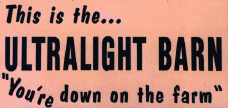 But unlike a bee hive this hive has many
"Queen Bees." These Queens unlike their counter parts work
together as a very cohesive unit. They have to because they do everything except fly the
planes. But unlike a bee hive this hive has many
"Queen Bees." These Queens unlike their counter parts work
together as a very cohesive unit. They have to because they do everything except fly the
planes.
While one group welcome newcomers and get them passes, another group
handles enquires, signs up and organizes volunteers, others arrange for coffee and donuts,
puts out the call for contacting staff, handles the volumes of enquires, sales of
merchandise, used articles, magazines, pins, coffee mugs, bulletin board information.
They
start work befo re the other volunteers start at 6 a.m. and they leave after everyone else
has gone - if I didn't re the other volunteers start at 6 a.m. and they leave after everyone else
has gone - if I didn't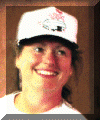 know
better I would have to suggest that some of them have to sleep at their posts to
accomplish everything that they do in the day. know
better I would have to suggest that some of them have to sleep at their posts to
accomplish everything that they do in the day.
But you know the amazing part about it - these women (I don't recall seeing any men) do it
in such a way that no matter how stupid your question seems, or how busy they are, the
treatment you receive from them is as if you were the most important person at the
convention! Whether you are a well know "legend in your own mind" such as
myself, or some guy that's waiting for his wife to get out of the Bingo Hall -
their focus and attention is YOU- no strings attached, no hand out for money, just
friendly, knowledgeable, understanding, individuals there to help you out. |
If you are a pilot wanting to
fly "Down at the Farm" then the first thing you will be doing each morning, or
at sometime during the day will be attending a flight briefing. So after you've had your
coffee and donut, dished out to you by the "gals" then the next group you will
meet will be the "Flight Briefing volunteers." One of the great things about
these people is they are not FAA or EAA or NTSB or...... - they are first and foremost
experienced ultr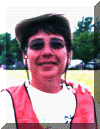 alight enthusiast, pilots,
owners, builders - with a major emphasis on "experienced." alight enthusiast, pilots,
owners, builders - with a major emphasis on "experienced."
They know where you
are going to be flying, how high, the problems, the safest emergency landing spots -
how? because they "have been there done that!"
In fact because of this the improvements in safety have been enormous. We
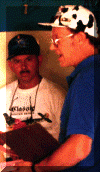 now have
Doppler Weather Radar which gives EXACT up to date weather for not only the
area of the show but all of the routes in and out. In years past the ultralight flight
pattern was shown to us in a very concise and scaled version model, aerial photos, etc. now have
Doppler Weather Radar which gives EXACT up to date weather for not only the
area of the show but all of the routes in and out. In years past the ultralight flight
pattern was shown to us in a very concise and scaled version model, aerial photos, etc.
This year an added feature was a video actually shot from an ultr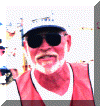 alight flying the exact circuit
we would be flying - talk about an exact birds eye view - to pull a major boner here would
be harder to explain than that escapade with the guy that was flying to California
and ended up in Ireland. alight flying the exact circuit
we would be flying - talk about an exact birds eye view - to pull a major boner here would
be harder to explain than that escapade with the guy that was flying to California
and ended up in Ireland.
Now once you've completed your briefing you then are given a
pass which indicates to the flag men that you have attended the briefing. That way some
bonehead who was to lazy to get up whose wife couldn't get him out of bed can't jump into
his plane and take off in the opposite circuit - SAFETY is first and foremost.
But even
the late risers aren't punished here - if you want to fly they make it so you can. In some
cases pilots are giv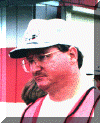 e e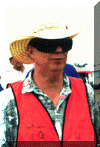 n
a SPECIAL one on one briefing in an effort to get anyone and everyone flying that wants to
fly. Why? Because they know you traveled a long way, have spent probably a great deal of
money that you really don't have to spend to attend something that is important to you. If
ultralight aviation is important to you then getting you flying "Down on the
Farm" is a priority to them. n
a SPECIAL one on one briefing in an effort to get anyone and everyone flying that wants to
fly. Why? Because they know you traveled a long way, have spent probably a great deal of
money that you really don't have to spend to attend something that is important to you. If
ultralight aviation is important to you then getting you flying "Down on the
Farm" is a priority to them.
Another added safety feature was the addition of an "ultralight spotter" up in
the "ultralight control tower." In years past the flag man would be located down
at one end of the field or the other. He was responsible for directly traffic for take-off
and landing.
This could be pretty hectic if you con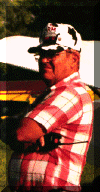 sider that on some days he would handle more take -offs and
landings than O'Hare airport the busiest in the world. The problems and responsibility put
on this one individual were enormous. One of the major problems was because of our low
circuit height and the treed terrain at both ends of the runway it was impo sider that on some days he would handle more take -offs and
landings than O'Hare airport the busiest in the world. The problems and responsibility put
on this one individual were enormous. One of the major problems was because of our low
circuit height and the treed terrain at both ends of the runway it was impo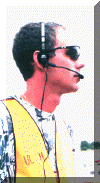 ssible to see just who was
landing, or where they were exactly in the circuit. ssible to see just who was
landing, or where they were exactly in the circuit.
Thus the flagman could flag someone
out to take off and have someone at the last minute appear on final - with neither
the pilot taking off nor the pilot landing knowing about each other. To prevent this the
spotter was in radio contact with the flagman - his location on top of the announcers
stand - and his 9 foot 6 inch height ( just kidding - but believe me the kid was TALL)
gave him an unobstructed view of those in the landing pattern.
He relayed this information
to the flagman who then could KNOWIN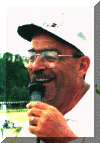 GLY
safely launch planes. GLY
safely launch planes.
About 5 years ago the ultralight end received speakers and a PA system. This meant they
needed announcers. I had the honour of working with "the voice of the farm"
Frank Beagle - together we made a great tandem. Unfortunately I rubbed someone in EAA the
wrong way and was promptly "banned from a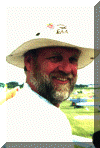 nnouncing." nnouncing."
Since then I think I have kissed every ass in EAA except maybe "Pope Paul" but
to no avail - I still remain on the black list. My shoes were aptly filled for the last
couple of years by Vern Peckham. Vern was unable to make the trip this year so Frank was
left to find a replacement - and he found a good one in .......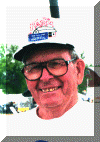
But Frank and ..... weren't the only ones up on the tower. After all this was an
"airport" and someone had to keep track of the landings and take offs, so a
specialist was brought in, and he sat there from first thing in the morning till last
thing at night - if ultralights were flying he was counting - rumour had it that nearly
4,000 take offs and landings were done in JUST the u ltralight section during the show.
Whatever happened to those ultralights that weren't able to fly because of wind? ltralight section during the show.
Whatever happened to those ultralights that weren't able to fly because of wind?
There is also another group of volunteers that may go unnoticed by the young and verile -
but us "older" - "couch potatoes" couldn't last at the show without.
These are the folks that give up their time to man the ultralight shuttles. Not only do
they shuttle you along nearly mile long route from one end of Oshkosh to the other but the
give you a very knowledgeable and informative guided tour while doing it.
|